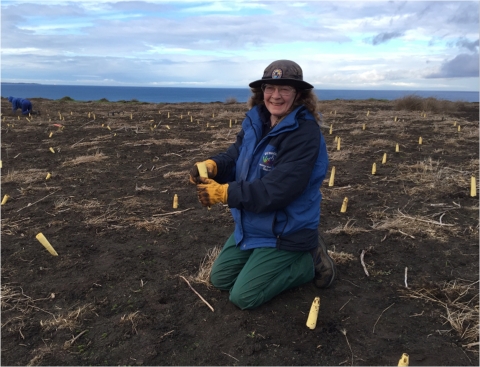What We Do
"The Refuge System will be fully engaged in the effort to conserve America’s great outdoors, leading when we can, and following when we should."
- Conserving the Future, Wildlife Refuges and the Next Generation, 2011
National Wildlife Refuge System Improvement Act
For almost a century, the 95-million-acre National Wildlife Refuge System had been managed by the U.S. Fish and Wildlife Service under a variety of laws without an "Organic Act" or comprehensive legislation spelling out how it ought to be managed and used by the public. On October 9, 1997, President Clinton signed the National Wildlife Refuge System Improvement Act of 1997. The Act amends the National Wildlife Refuge System Administration Act of 1966 in a manner that provides an “Organic Act” for the Refuge System. The Act was passed to ensure that the Refuge System is managed as a national system of related lands, waters, and interests for the protection and conservation of our Nation's wildlife resources.
The Act defines a unifying mission for all refuges, including a process for determining compatible uses on refuges, and requiring that each refuge be managed according to a comprehensive conservation plan (CCP). It expressly states that wildlife conservation is the priority of System lands and that the Secretary shall ensure that the biological integrity, diversity, and environmental health of refuge lands are maintained. Each refuge must be managed to fulfill the specific purposes for which the refuge was established and the System mission. The first priority of each refuge is to conserve, manage, and if needed, restore fish and wildlife populations and habitats according to its purpose.
The only system of Federal lands devoted specifically to wildlife, the National Wildlife Refuge System is a network of diverse and strategically located habitats. More than 545 national wildlife refuges and thousands of waterfowl production areas across the United States teem with millions of migratory birds, serve as havens for hundreds of endangered species, and host an enormous variety of other plants and animals. Over 39 million people visit units of the National Wildlife Refuge System each year to enjoy a wide range of wildlife related recreational opportunities.
The passage of this Act gave guidance to the Secretary of the Interior for the overall management of the Refuge System. The Act's main components include:
- a strong and singular wildlife conservation Mission for the Refuge System
- a requirement that the Secretary of the Interior maintain the biological integrity, diversity and environmental health of the Refuge System
- a new process for determining compatible uses on refuges
- a recognition that wildlife-dependent recreational uses involving hunting, fishing, wildlife observation and photography, and environmental education and interpretation, when determined to be compatible, are legitimate and appropriate public uses of the Refuge System
- confirmation that these compatible wildlife-dependent recreational uses are the priority general public uses of the Refuge System
- the requirement to complete a comprehensive conservation plan (CCP) for each refuge
Management and Conservation
Refuge Planning
Comprehensive Conservation Plan
The primary planning document for a refuge is called a "comprehensive conservation plan" or CCP. Under the National Wildlife Refuge Improvement Act of 1997 each refuge in the National Wildlife Refuge System is required to periodically complete a CCP to guide management over a fifteen-year period. Each refuge must be managed to fulfill the NWRS mission and the specific purposes for which that refuge was established.
The CCP includes the goals, objectives, and strategies for improving refuge conditions including the types of habitat provided, partnership opportunities, and management actions needed to achieve desired conditions. The Service’s preferred alternative for managing the refuge and its effects on the human environment are described in the CCP as well. Additionally, during the CCP writing process the public is encouraged to participate in planning meetings and to submit comments within a specified time frame.
Learn about the Comprehensive Conservation Plan that will guide the Refuge into the future.
Our Projects and Research
Protection Island Restoration
The project germinated while drafting the Protection Island NWR Comprehensive Conservation Plan which was signed in 2010. The goal is to restore up to 200 acres of upland prairie habitat. The project began in 2015 with a test plot to determine if the threatened golden paintbrush (Castilleja levisecta) could be re-introduced to the island. That successful test led to progressively larger experimental plots to test treatment methods for removing non-native vegetation, prescribed fire suitability, seed mixes, and seeding methods. Staff, volunteers and partners have made great progress in understanding how to best move forward with restoring native prairie habitat on Protection Island.
Research
Refuge staff conduct research and monitoring on Protection Island annually. Projects have included quantifying abundance and distribution of wildlife on the island during the breeding and non-breeding season, studies focused on seabird diet and productivity as well as native pollinator inventories. Various partners also implement targeted research on both Protection Island NWR and the Zella Schultz Seabird Sanctuary including seabird occupancy, diet and productivity studies, response to changing ocean conditions, health assessments, and forage fish productivity.
Law Enforcement
The mission of US Fish and Wildlife law enforcement is to protect wildlife and plant resources. Through the effective enforcement of Federal laws we contribute to Fish and Wildlife Service efforts to recover endangered species, conserve migratory birds, preserve wildlife habitat, safeguard fisheries, combat invasive species invasive species
An invasive species is any plant or animal that has spread or been introduced into a new area where they are, or could, cause harm to the environment, economy, or human, animal, or plant health. Their unwelcome presence can destroy ecosystems and cost millions of dollars.
Learn more about invasive species , and promote international wildlife conservation.




